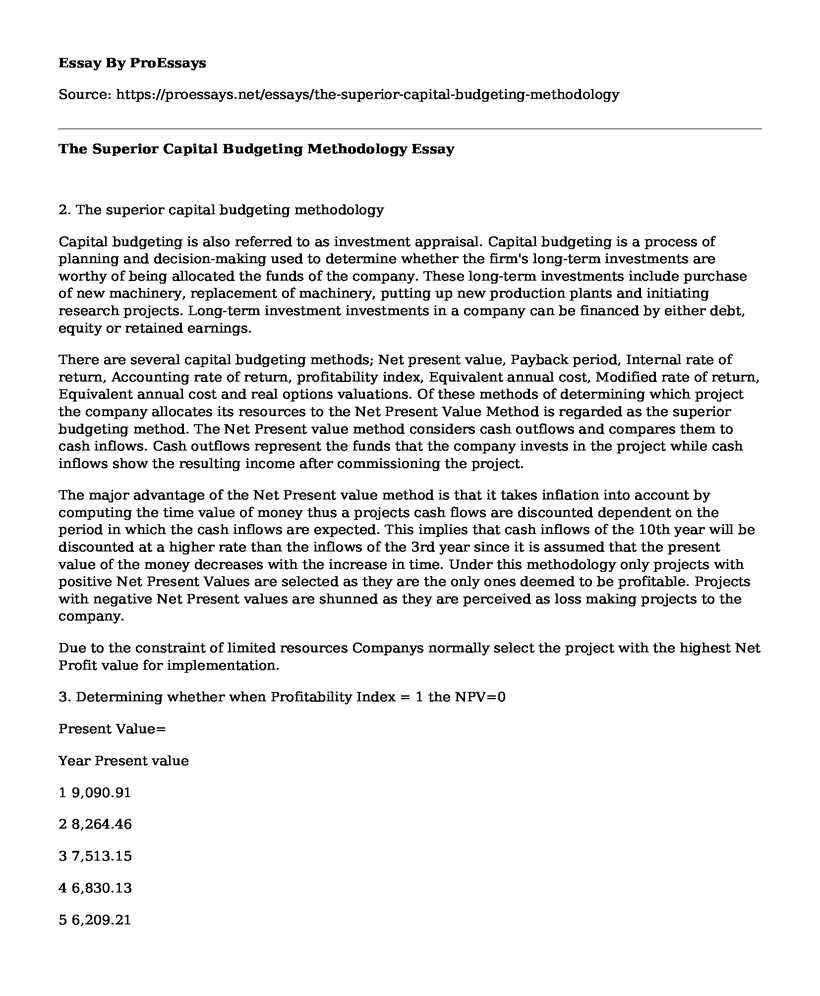2. The superior capital budgeting methodology
Capital budgeting is also referred to as investment appraisal. Capital budgeting is a process of planning and decision-making used to determine whether the firm's long-term investments are worthy of being allocated the funds of the company. These long-term investments include purchase of new machinery, replacement of machinery, putting up new production plants and initiating research projects. Long-term investment investments in a company can be financed by either debt, equity or retained earnings.
There are several capital budgeting methods; Net present value, Payback period, Internal rate of return, Accounting rate of return, profitability index, Equivalent annual cost, Modified rate of return, Equivalent annual cost and real options valuations. Of these methods of determining which project the company allocates its resources to the Net Present Value Method is regarded as the superior budgeting method. The Net Present value method considers cash outflows and compares them to cash inflows. Cash outflows represent the funds that the company invests in the project while cash inflows show the resulting income after commissioning the project.
The major advantage of the Net Present value method is that it takes inflation into account by computing the time value of money thus a projects cash flows are discounted dependent on the period in which the cash inflows are expected. This implies that cash inflows of the 10th year will be discounted at a higher rate than the inflows of the 3rd year since it is assumed that the present value of the money decreases with the increase in time. Under this methodology only projects with positive Net Present Values are selected as they are the only ones deemed to be profitable. Projects with negative Net Present values are shunned as they are perceived as loss making projects to the company.
Due to the constraint of limited resources Companys normally select the project with the highest Net Profit value for implementation.
3. Determining whether when Profitability Index = 1 the NPV=0
Present Value=
Year Present value
1 9,090.91
2 8,264.46
3 7,513.15
4 6,830.13
5 6,209.21
6 5,644.74
7 5,131.58
8 4,665.07
9 4,240.98
10 3,855.43
11 3,504.94
12 3,186.31
68,136.92
PROFITABILITY INDEX METHOD
Profitability Index=
Profitability Index =
Profitability Index=1
NET PRESENT VALUE METHOD
The cash outflow/investment to the project is $ 68.136.92
The Net present value=Present value cash inflows-Cost of the Project/cash outflow
Thus from the workings
NPV= $68,136.92-$68,136.92
NPV=0
From the above computations it can be concluded that when the Profitability Index of an investment =1 the Net Present Value=0
4. Coefficient of Variation
The coefficient of variation is used in comparing the variation in one data set to another provided data set. It is also referred to as the relative standard of deviation. It is used to measure dispersion, probability and frequency distribution.
Asset A
State of the Economy Probability Expected Returns
High 0.25 30%
Average 0.60 25%
Low 0.15 40%
Expected returns = (0.2530%) + (0.6025%) + (0.1540%)
Expected Returns=28.5%
Variance = (0.25) (0.3-0.25)2 + (0.60) (0.25-0.25)2+ (0.15) (0.40-0.25)2
Variance=0.004
Standard Deviation= (variance)
Standard Deviation=0.004
Standard Deviation=0.0632
Coefficient of variation =
Coefficient of variation =
Coefficient of Variation = 0.2218
Asset B
State of the Economy Probability Expected Returns
High 0.20 28%
Average 0.50 35%
Low 0.30 48%
Expected returns= (0.2028%) + (0.5035%) + (0.3048%)
Expected Returns = 37.5%
Variance = (0.35) (0.28-0.35)2 + (0.50) (0.35-0.35)2+ (0.30) (0.48-0.35)2
Variance=0.0068
Standard Deviation= (variance)
Standard Deviation=0.0068
Standard Deviation=0.0823
Coefficient of variation =
Coefficient of variation =
Coefficient of Variation = 0.2197
Asset B provides the best set of risk adjusted returns as it has a lower coefficient of variation which is an indicator of lesser risk
Cite this page
The Superior Capital Budgeting Methodology. (2021, Mar 08). Retrieved from https://proessays.net/essays/the-superior-capital-budgeting-methodology
If you are the original author of this essay and no longer wish to have it published on the ProEssays website, please click below to request its removal:
- Paper Sample on School Funding
- Demographics and Cultural Shifts That Are Driving the Demand for Investment Services
- Deductions and Losses: Certain Itemized Deductions
- CSR and Sustainability of the Oman Oil Company
- Essay Sample on Healthcare Fraud
- Essay Example on Financial Future of Medicare
- Essay on Money Laundering: Destructive Risk to State, Banks and Community







